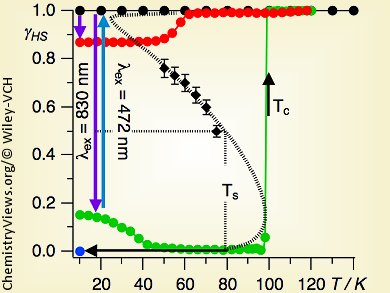Highly cooperative systems are required for the design of efficient optical switching and memory devices at higher temperatures. A pan European collaboration between researchers in Switzerland, France, Romania, and Poland, led by Andreas Hauser at the University of Geneva, Switzerland, have found quantitative, persistent, wavelength-selective bidirectional optical spin state switching between 10 and 100 K for an iron(II) triazole complex.
Tris[1,4-di(1,2,3-triazol-1-yl)butane]iron(II) tetrafluoroborate exists in a high-spin state down to temperatures as low as 10 K. However, upon radiation with red light at this temperature, the complex undergoes a fully reversible light-induced excited-spin-state trapping (LIESST) effect. This photo-generated low-spin state can then be transformed back to the high-spin state by irradiation with blue/green light. Thermal and kinetic studies show that there is a threshold temperature above which the high-spin state is recovered, but below which the low-spin state is more stable.
This light-induced bistability, together with the full photophysical reversibility constitutes an important step towards possible molecular switching applications.
- Light-Induced Bistability in the 2D Coordination Network {[Fe(bbtr)3][BF4]2}∞: Wavelength-Selective Addressing of Molecular Spin States,
P. Chakraborty, S. Pillet, E.-E. Bendeif, C. Enachescu, R. Bronisz, A. Hauser,
Chem. Eur. J. 2013.
DOI: 10.1002/chem.201301257




